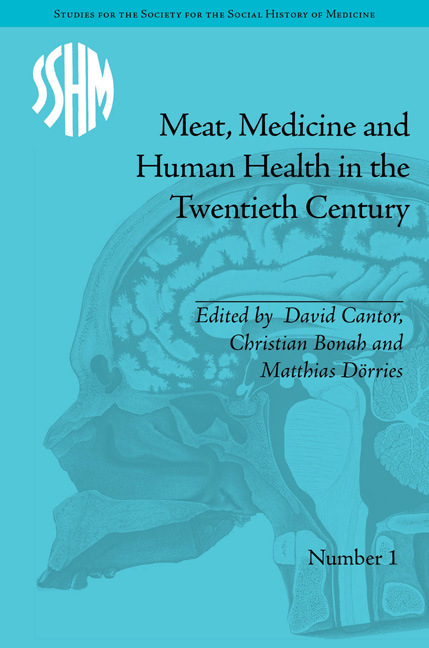Book contents
- Frontmatter
- CONTENTS
- Acknowledgements
- List of Contributors
- List of Figures and Tables
- Introduction
- Part 1 Meat and Therapeutics
- Part II Meat, Politics and Culture
- Part III Meat, Risk and Regulation
- 9 Mad and Coughing Cows: Bovine Tuberculosis, BSE and Health in Twentieth-Century Britain
- 10 Food, Drug and Consumer Regulation: The ‘Meat, DES and Cancer’ Debates in the United States
- Notes
- Index
9 - Mad and Coughing Cows: Bovine Tuberculosis, BSE and Health in Twentieth-Century Britain
from Part III - Meat, Risk and Regulation
- Frontmatter
- CONTENTS
- Acknowledgements
- List of Contributors
- List of Figures and Tables
- Introduction
- Part 1 Meat and Therapeutics
- Part II Meat, Politics and Culture
- Part III Meat, Risk and Regulation
- 9 Mad and Coughing Cows: Bovine Tuberculosis, BSE and Health in Twentieth-Century Britain
- 10 Food, Drug and Consumer Regulation: The ‘Meat, DES and Cancer’ Debates in the United States
- Notes
- Index
Summary
Since the 1950s, consumers have come to expect cheap, but safe food. A number of food scares in the 1980s and 90s – E. coli in 1987, Salmonella in 1988, and the furore over GM ingredients – challenged this expectation. Of all these scares Bovine Spongiform Encephalopathy (BSE) or ‘mad cow disease’, although coming at the end of a decade of food scares, came to embody the fears that had come to surround issues of food safety.
However, the threat from a zoonotic disease and meat are not unique to the late twentieth century. Whereas social scientists have suggested that an obsession with food quality is characteristic of a modern western society, across Europe and North America animal plagues and food safety became important medical, social and political questions in the nineteenth century. In Britain, apprehension about the dangers of consuming adulterated or unwholesome food was present in the mid-nineteenth century, but more was at stake than just questions of quality and composition. After 1850, meat from diseased livestock emerged as a defined danger to health. Regular outbreaks of foot-and-mouth, rabies and pleuro-pneumonia fuelled anxiety, but it was bovine tuberculosis that came to dominate debate about the relationship between animal diseases and human health. In the process, tuberculous meat became symbolic of the dangers represented by meat from diseased livestock.
- Type
- Chapter
- Information
- Meat, Medicine and Human Health in the Twentieth Century , pp. 159 - 178Publisher: Pickering & ChattoFirst published in: 2014



